-

新人教版高中英语必修2Unit 3 The Internet-Reading For Writing教案一
⑦identity theft 身份盗窃⑧chat room 聊天室⑨draft your blog post 起草博客帖子⑩post embarrassing photos 张贴尴尬照片 【话题句式】 1. How do you stay safe online and avoid bad experiences on the Internet? 你如何在网上保持安全, 避免在网上的不良经历? 2. I’m not an expert, but many years as a blogger have taught me a thing or two. 我不是专家, 但作为一个博主, 我已经学了好几年了。 3. If you see or read something that makes you feel uncomfortable, leave the site immediately. 如果你看到或读到一些让你觉得不舒服的东西, 立即离开这个网站。4. Don’t give out your address or phone number. 别告诉别人你的地址或电话号码。 5. Identity theft is a common and serious problem. 身份盗窃是一个常见而严重的问题。6. Being online is no excuse for being rude, and you don’t want to become a target for a troll or cyberbully. 上网并不是无礼的借口, 你也不想成为发挑衅帖子的人或网络恶霸的目标。 7. Trolls often use several false names so that they can stay on a site. 发挑衅帖子的人经常使用几个假名, 这样他们就可以留在一个网站上。8. However, the more polite you are, the less likely it is you will be attacked. 然而, 你越有礼貌, 你被攻击的可能性就越小。

新人教版高中英语必修2Unit 4 History and Traditions-Reading and Thinking教案一
Features of languages1.Finally, in the 20th century, the southern part of Ireland broke away from the UK, which resulted in the full name we have today: the United Kingdom of Great Britain and Northern Ireland.该句是一个复合句。该句主句为:the southern part of Ireland broke away from the UK;which resulted in the full name we have today为which引导的定语从句代指前面整句话的内容,we have today为定语从句修饰先行词name。译文:最后,在20世纪,爱尔兰南部脱离英国,这导致了我们今天有的英国的全名:大不列颠及北爱尔兰联合王国。2.Almost everywhere you go in the UK, you will be surrounded by evidence of four different groups of people who took over at different times throughout history.该句是一个复合句。该句主句为:you will be surrounded by evidence of four different groups of people;其中Almost everywhere you go in the UK为让步状语从句; who took over at different times throughout history为定语从句修饰先行词people。译文:几乎无论你走到英国的任何地方,你都会发现历史上有四种不同的人在不同的时期统治过英国。3.The capital city London is a great place to start, as it is an ancient port city that has a history dating all the way back to Roman times.该句是一个复合句。该句主句为:The capital city London is a great place to start; as it is an ancient port city that has a history dating all the way back to Roman times.为原因状语从句;dating all the way back to Roman times为现在分词短语作定语修饰history。

新人教版高中英语必修2Unit 5 Music-Discovering Useful Structures教案一
Step1:自主探究。1.(教材P52)Born(bear) in the USA on 2 January 1970, Whitacre began studying music at the University of Nevada in 1988.2.(教材P52) Moved(move) by this music, he said, “It was like seeing color for the first time.”3.(教材P56)I was very afraid and I felt so alone and discouraged(discourage).4.(教材P58)Encouraged(encourage) by this first performance and the positive reaction of the audience, I have continued to play the piano and enjoy it more every day.Step2:语法要点精析。用法1:过去分词作表语1).过去分词可放在连系动词be, get, feel, remain, seem, look, become等之后作表语,表示主语所处的状态Tom was astonished to see a snake moving across the floor.汤姆很惊讶地看到一条蛇正爬过地板。Finally the baby felt tired of playing with those toys.终于婴儿厌倦了玩那些玩具。注意:1).过去分词作表语时与被动语态的区别过去分词作表语时,强调主语所处的状态;而动词的被动语态表示主语是动作的承受者,强调动作。The library is now closed.(状态)图书馆现在关闭了。The cup was broken by my little sister yesterday.(动作)昨天我妹妹把杯子打碎了。2)感觉类及物动词的现在分词与过去分词作表语的区别过去分词作表语多表示人自身的感受或事物自身的状态,常译作“感到……的”;现在分词多表示事物具有的特性,常译作“令人……的”。
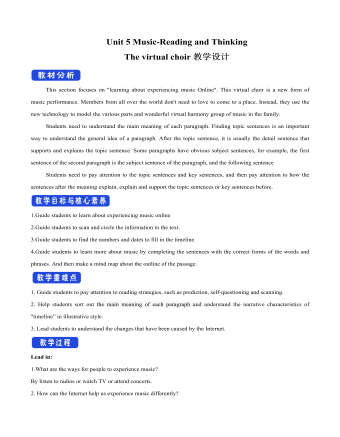
新人教版高中英语必修2Unit 5 Music-Reading and Thinking教案一
This section focuses on "learning about experiencing music Online". This virtual choir is a new form of music performance. Members from all over the world don't need to love to come to a place. Instead, they use the new technology to model the various parts and wonderful virtual harmony group of music in the family. Students need to understand the main meaning of each paragraph. Finding topic sentences is an important way to understand the general idea of a paragraph. After the topic sentence, it is usually the detail sentence that supports and explains the topic sentence. Some paragraphs have obvious subject sentences, for example, the first sentence of the second paragraph is the subject sentence of the paragraph, and the following sentenceStudents need to pay attention to the topic sentences and key sentences, and then pay attention to how the sentences after the meaning explain, explain and support the topic sentences or key sentences before.1.Guide students to learn about experiencing music online2.Guide students to scan and circle the information in the text.3.Guide students to find the numbers and dates to fill in the timeline.4.Guide students to learn more about music by completing the sentences with the correct forms of the words and phrases. And then make a mind map about the outline of the passage.1. Guide students to pay attention to reading strategies, such as prediction, self-questioning and scanning.2. Help students sort out the main meaning of each paragraph and understand the narrative characteristics of "timeline” in illustrative style.3. Lead students to understand the changes that have been caused by the Internet.

新人教版高中英语必修2Unit 5 Music-Reading For Writing教案一
(4)Now we have heard a number of outstanding speeches ... 我们已经聆听了许多精彩的发言……(5)Because we wanted the nations of the world, working together, to deal with ... 因为我们希望全世界各国团结起来去应对……(6)And if we do not act ... 如果我们不采取行动……(7)Now, I share the concerns that have been expressed ... 我也同意对于……表达的担心(8)Let us show the world that by working together we can ... 让我们告诉全世界,通过一起努力我们可以……(9)It is now time for us to ... 是时候我们……(10)And I have always wished that ... 我一直希望……(11)Thank you for letting me share this day with me.感谢你们和我共度这一天。实践演练:假如你是高中生李华,你校将举办一次以“音乐”为主题的演讲比赛,请你按照主题,写下你的演讲稿。注意:词数100左右。First of all, thank you for listening to my speech. My topic is: love music like love yourself.Music is like the air we need to maintain our normal lives around us. You can't imagine how terrible a world without music would be. Movies and TV shows have no music, only dry conversations and scenes; mobile phones only vibrations; streets only noisy crowds; cafes, western restaurants only depressed meals. What a terrible world it is!As a student, I hope we all can enjoy the fun brought by music in our spare time. Instead of just listening to music, we can even make our own music. Let's enjoy the fun of music!Thanks again for your attention!

新人教版高中英语必修3Unit 1 Festivals and Celebrations教学设计一
本板块的活动主题是“谈论节日活动”(Talk about festival activities),主要是从贴近学生日常生活的角度来切入“节日”主题。学生会听到发生在三个国家不同节日场景下的简短对话,对话中的人们正在参与或将要亲历不同的庆祝活动。随着全球化的进程加速,国际交流日益频繁,无论是国人走出国门还是外国友人访问中国,都已成为司空见惯的事情。因此,该板块所选取的三个典型节日场景都是属于跨文化交际语境,不仅每组对话中的人物来自不同的文化背景,对话者的身份和关系也不尽相同。1. Master the new words related to holiday: the lantern, Carnival, costume, dress(sb)up, march, congratulation, congratulate, riddle, ceremony, samba, make - up, after all. 2. To understand the origin of major world festivals and the activities held to celebrate them and the significance of these activities;3. Improve listening comprehension and oral expression of the topic by listening and talking about traditional festivals around the world;4. Improve my understanding of the topic by watching pictures and videos about different traditional festivals around the world;5. Review the common assimilation phenomenon in English phonetics, can distinguish the assimilated phonemes in the natural language flow, and consciously use the assimilation skill in oral expression. Importance:1. Guide students to pay attention to the attitude of the speaker in the process of listening, and identify the relationship between the characters;2. Inspire students to use topic words to describe the festival activities based on their background knowledge. Difficulties:In the process of listening to the correct understanding of the speaker's attitude, accurately identify the relationship between the characters.

新人教版高中英语必修3Unit 2 Morals and virtues教学设计一
(2) students are divided into groups according to the requirements of activity 3. Each student shares a story of personal experience or hearing-witnessing kindness, and then selects the most touching story in the group and shares it with the whole class. Before the students share the story, the teacher can instruct them to use the words and sentence patterns in the box to express. For example, the words in the box can be classified:Time order: first of all, then, after that, later, finally logical relationship :so, however, although, butTeachers can also appropriately add some transitional language to enrich students' expression:Afterwards, afterwards, at last, in the end, eventuallySpatial order: next to, far from, on the left, in front ofOtherwise, nevertheless, as a result, therefore, furthermore, in addition, as well asSummary: in a word, in short, on the whole, to sum up, in briefStep 8 Homework1. Understand the definition of "moral dilemma" and establish a correct moral view;2. Accumulate vocabulary about attitudes and emotions in listening texts and use them to express your own views;3. Complete relevant exercises in the guide plan.1、通过本节内容学习,学生能否理解理解“道德困境”的定义;2、通过本节内容学习,学生能否通过说话人所表达的内容、说话的语气、语调等来判断其态度和情绪;3、通过本节内容学习,学生能否针对具体的道德困境发表自己的看法和见解,能否掌握听力理训练中的听力策略。

新人教版高中英语必修3Unit 3 Diverse Cultures教学设计一
Activity 81.Grasp the main idea of the listening.Listen to the tape and answer the following questions:Who are the two speakers in the listening? What is their relationship?What is the main idea of the first part of the listening? How about the second part?2.Complete the passage.Ask the students to quickly review the summaries of the two listening materials in activity 2. Then play the recording for the second time.Ask them to complete the passage and fill in the blanks.3.Play the recording again and ask the students to use the structure diagram to comb the information structure in the listening.(While listening, take notes. Capture key information quickly and accurately.)Step 8 Talking Activity 91.Focus on the listening text.Listen to the students and listen to the tape. Let them understand the attitudes of Wu Yue and Justin in the conversation.How does Wu Yue feel about Chinese minority cultures?What does Justin think of the Miao and Dong cultures?How do you know that?2.learn functional items that express concerns.Ask students to focus on the expressions listed in activity. 3.And try to analyze the meaning they convey, including praise (Super!).Agree (Exactly!)"(You're kidding.!)Tell me more about it. Tell me more about it.For example, "Yeah Sure." "Definitely!" "Certainly!" "No kidding!" "No wonder!" and so on.4.Ask the students to have conversations in small groups, acting as Jsim and his friends.Justin shares his travels in Guizhou with friends and his thoughts;Justin's friends should give appropriate feedback, express their interest in relevant information, and ask for information when necessary.In order to enrich the dialogue, teachers can expand and supplement the introduction of Miao, dong, Lusheng and Dong Dage.After the group practice, the teacher can choose several groups of students to show, and let the rest of the students listen carefully, after listening to the best performance of the group, and give at least two reasons.

中班语言课件教案:兔子先生去散步
第一环节,我以兔子的家为导入,看看猜猜,“这是谁的家啊?”让孩子在细致地观察中发现,培养阅读观察的能力。第二环节,是活动的重点,用看图猜谜的活动形式层层引入,根据故事中的标志联想故事的情节。当然在过程中谜底不是绝对的,例如眼泪的那段,也可以是雨滴、水滴、油滴,以引发孩子的讨论。在整个欣赏的过程中注重故事的完整性,在分段欣赏时,从故事开始到“小心坑洞”的那段,内容基本不变,后面的一段留一个疑问,“兔子先生掉到洞里后会碰到什么呢?”引起孩子完整欣赏故事的兴趣,在完整欣赏时了解答案。 第三环节,注重将文学作品回归到孩子的生活中。引导孩子交流讨论生活周围的图象与符号,自然引入社会认知的活动,活动有可持续发展的价值,如延伸活动“寻找生活中的标志、幼儿园、马路上的标志等等。

《念奴娇 赤壁怀古》说课稿(一) 统编版高中语文必修上册
一、说教材:(一)教材的地位和作用《念奴娇﹒赤壁怀古》是部编版高中语文教材必修上册第9课的课文。它与辛弃疾的《永遇乐﹒京口北固亭怀古》,李清照的《声声慢》共同入选该册教材第三单元阅读古诗词,感悟人生这一学习专题。本词是苏轼的代表作,也是豪放词的名篇,在古诗词教学中占有重要的地位。优美的诗词是中华传统文化的瑰宝,学习这些诗词的目的在于培养学生鉴赏古代诗词作品的能力,在分析、鉴赏中感悟前人丰饶的情思,博大的智慧,从而提高学生的人文素养,提高文化品味。这首词写于元丰五年,是苏轼被贬黄州游赤鼻矶所作。本词感情激荡,意境雄浑壮阔。全词融写景、咏史、抒情为一体。通过学习,学生可以获得一些鉴赏诗词的基本要领,领略壮阔意境,感受豪放词风;同时学习苏轼在逆境中依然乐观旷达的人生观。
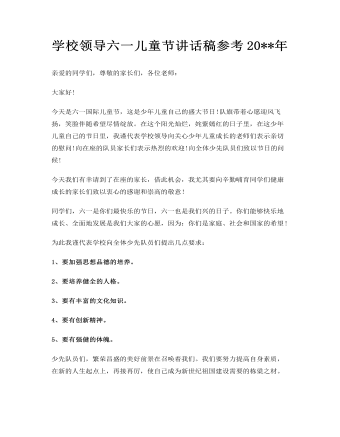
学校领导六一儿童节讲话稿参考2023年
大家早上好!在这个阳光灿烂,姹紫嫣红的日子里,我们怀着喜悦的心情在这里欢聚一堂,庆祝孩子们的盛大节日六一国际儿童节。在这喜庆的日子里,我代表___幼儿园全体教师职工祝小朋友们节日快乐,健康成长。向在坐的各位来宾以及家长朋友们表示最热烈的欢迎和最诚挚的谢意,因为你们今天来到这里,不仅仅是为了观看孩子们的演出,最最重要的是你们对孩子成长的关注、对教育的关注,也是对我们幼教工作的关注,因为有了你们的支持与配合,宽容与理解,我们的幼教事业才得以发展。谢谢你们对幼教事业的关心和支持,谢谢你们对小朋友们的关爱,让我们共同担起培养祖国花朵的重任,让我们的孩子有一个绚丽多彩的明天。同时也祝愿所有的小朋友们节日快乐,身体健康,茁壮成长。
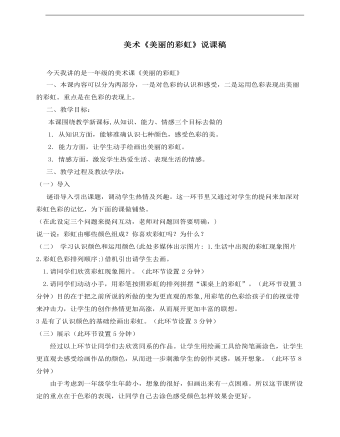
小学美术冀美版一年级上册《天边的彩虹》说课稿
(一)导入 谜语导入引出课题,调动学生热情及兴趣。这一环节里又通过对学生的提问来加深对彩虹色彩的记忆,为下面的课做铺垫。(在此设定三个问题来提问互动,老师对问题回答要明确,)说一说:彩虹由哪些颜色组成?你喜欢彩虹吗?为什么?(二) 学习认识颜色和运用颜色(此处多媒体出示图片: 1.生活中出现的彩虹现象图片2.彩虹色彩排列顺序;)借机引出请学生去画。 1.请同学们欣赏彩虹现象图片。(此环节设置2分钟)2.请同学们动动小手,用彩笔按照彩虹的排列拼摆“课桌上的彩虹”。(此环节设置3分钟)目的在于把之前所说的所做的变为更直观的形象,用彩笔的色彩给孩子们的视觉带来冲击力,让学生的创作热情更加高涨,从而展开更加丰富的联想。3是有了认识颜色的基础绘画出彩虹。(此环节设置3分钟)
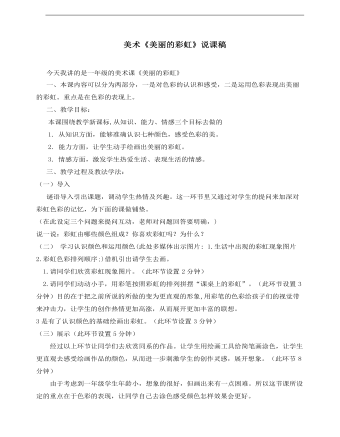
小学美术冀美版一年级上册《9天边的彩虹》说课稿
(一)导入 谜语导入引出课题,调动学生热情及兴趣。这一环节里又通过对学生的提问来加深对彩虹色彩的记忆,为下面的课做铺垫。(在此设定三个问题来提问互动,老师对问题回答要明确,)说一说:彩虹由哪些颜色组成?你喜欢彩虹吗?为什么?(二) 学习认识颜色和运用颜色(此处多媒体出示图片: 1.生活中出现的彩虹现象图片2.彩虹色彩排列顺序;)借机引出请学生去画。
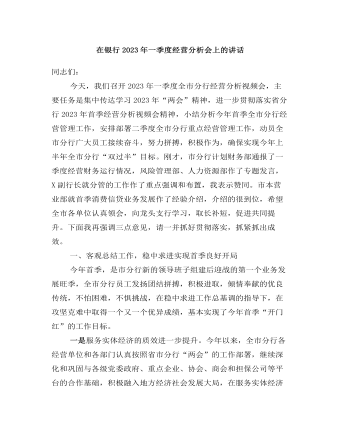
在银行2023年一季度经营分析会上的讲话
同志们:今天,我们召开2023年一季度全市分行经营分析视频会,主要任务是集中传达学习2023年“两会”精神,进一步贯彻落实省分行2023年首季经营分析视频会精神,小结分析今年首季全市分行经营管理工作,安排部署二季度全市分行重点经营管理工作,动员全市分行广大员工接续奋斗,努力拼搏,积极作为,确保实现今年上半年全市分行“双过半”目标。刚才,市分行计划财务部通报了一季度经营财务运行情况,风险管理部、人力资源部作了专题发言,X副行长就分管的工作作了重点强调和布置,我表示赞同。市本营业部就首季消费信贷业务发展作了经验介绍,介绍的很到位,希望全市各单位认真领会,向龙头支行学习,取长补短,促进共同提升。下面我再强调三点意见,请一并抓好贯彻落实,抓紧抓出成效。一、客观总结工作,稳中求进实现首季良好开局今年首季,是市分行新的领导班子组建后迎战的第一个业务发展旺季,全市分行员工发扬团结拼搏,积极进取,倾情奉献的优良传统,不怕困难,不惧挑战,在稳中求进工作总基调的指导下,在攻坚克难中取得一个又一个优异成绩,基本实现了今年首季“开门红”的工作目标。
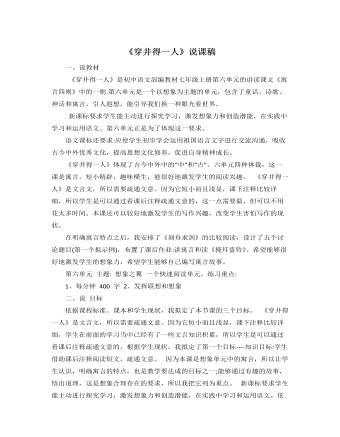
部编版语文七年级上册《穿井得一人》说课稿
一、说教材《穿井得一人》是初中语文部编教材七年级上册第六单元的讲读课文《寓言四则》中的一则.第六单元是一个以想象为主题的单元,包含了童话、诗歌、神话和寓言,引人遐想,能引导我们换一种眼光看世界。新课标要求学生能主动进行探究学习,激发想象力和创造潜能,在实践中学习和运用语文。第六单元正是为了体现这一要求。语文课标还要求:应使学生初步学会运用祖国语言文字进行交流沟通,吸收古今中外优秀文化,提高思想文化修养,促进自身精神成长。《穿井得一人》体现了古今中外中的“中”和“古”。六单元四种体裁,这一课是寓言,短小精辟,趣味横生,能很好地激发学生的阅读兴趣。 《穿井得一人》是文言文,所以需要疏通文意。因为它短小而且浅显,课下注释比较详细,所以学生是可以通过看课后注释疏通文意的,这一点需要做,但可以不用花太多时间。本课还可以较好地激发学生的写作兴趣,改变学生害怕写作的现状。
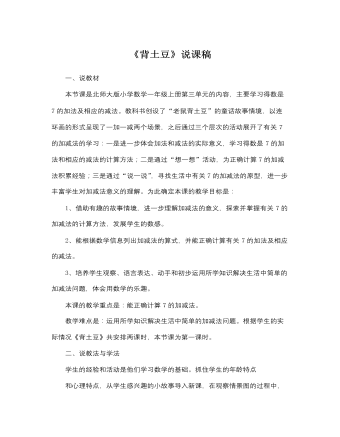
北师大版小学数学一年级上册《背土豆》说课稿
本课的教学重点是:能正确计算7的加减法。教学难点是:运用所学知识解决生活中简单的加减法问题。根据学生的实际情况《背土豆》共安排两课时,本节课为第一课时。二、说教法与学法学生的经验和活动是他们学习数学的基础。抓住学生的年龄特点和心理特点,从学生感兴趣的小故事导入新课,在观察情景图的过程中,既培养学生的观察能力和语言表达能力,又激发了学生学习数学的兴趣。同时充分利用了学具和多媒体教学手段,调动学生多种感官参与学习。整节课以故事为主线,把教学内容串了起来,尽可能地激发学生的求知欲望。教学过程紧扣教材,根据学生的实际适时引导。有效的学习就是激励学生动手实践、自主探索与合作交流。本课教学中,我尽可能地引导学生自主提问,自己解决问题,让学生在探索、操作、交流获取新知。
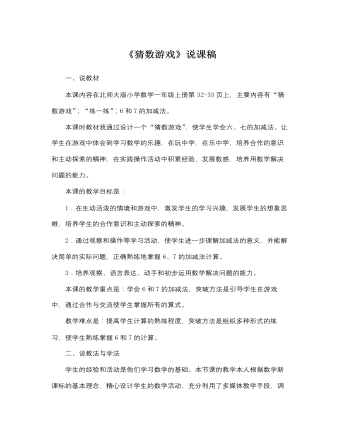
北师大版小学数学一年级上册《猜数游戏》说课稿
二、说教法与学法学生的经验和活动是他们学习数学的基础。本节课的教学本人根据数学新课标的基本理念,精心设计学生的数学活动,充分利用了多媒体教学手段,调动学生多种感官参与学习。让学生在实际中运用所学知识,体现了数学来源于生活,生活离不开数学。整节课以游戏、活动为主线,把教学内容清晰有趣地串了起来,设计了新颖的情景教学和动画故事,尽可能的激发学生的求知欲望。教学过程紧扣教材,层层递进,环环相扣,教师能根据学生的实际适时的引导,使整节课能顺利完成教学任务。有效的学习就是激励学生动手实践、自主探索与合作交流。本课教学中,本人就注意实践操作与游戏活动有机地结合,让学生在玩、交流中思考,在思考中探索,获取新知。三、说教学过程本节课的教学我主要设计了六个环节:提问导入、猜数游戏、实际应用、回顾总结、课堂作业。
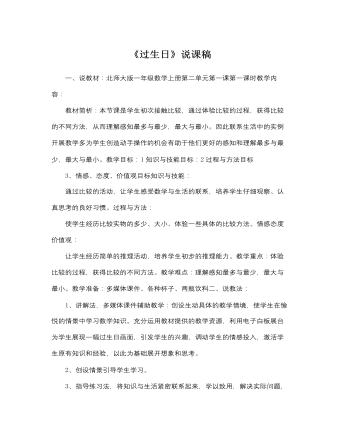
北师大版小学数学一年级上册《过生日》说课稿
3、情感、态度、价值观目标知识与技能:通过比较的活动,让学生感受数学与生活的联系,培养学生仔细观察、认真思考的良好习惯。过程与方法:使学生经历比较实物的多少、大小、体验一些具体的比较方法。情感态度价值观:让学生经历简单的推理活动,培养学生初步的推理能力。教学重点:体验比较的过程,获得比较的不同方法。教学难点:理解感知最多与最少,最大与最小。教学准备:多媒体课件、各种杯子、两瓶饮料二、说教法:1、讲解法,多媒体课件辅助教学:创设生动具体的教学情境,使学生在愉悦的情景中学习数学知识。充分运用教材提供的教学资源,利用电子白板展台为学生展现一幅过生日画面,引发学生的兴趣,调动学生的情感投入,激活学生原有知识和经验,以此为基础展开想象和思考。
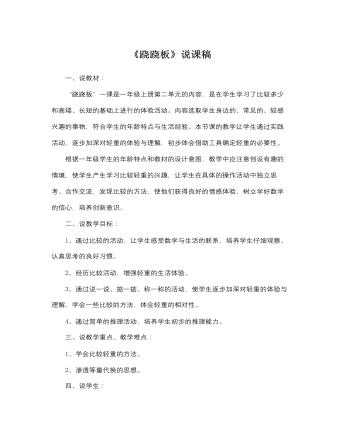
北师大版小学数学一年级上册《跷跷板》说课稿
一、说教材:“跷跷板”一课是一年级上册第二单元的内容,是在学生学习了比较多少和高矮、长短的基础上进行的体验活动。内容选取学生身边的、常见的、较感兴趣的事物,符合学生的年龄特点与生活经验。本节课的教学让学生通过实践活动,逐步加深对轻重的体验与理解,初步体会借助工具确定轻重的必要性。根据一年级学生的年龄特点和教材的设计意图,教学中应注意创设有趣的情境,使学生产生学习比较轻重的兴趣,让学生在具体的操作活动中独立思考、合作交流,发现比较的方法,使他们获得良好的情感体验,树立学好数学的信心,培养创新意识。二、说教学目标:1、通过比较的活动,让学生感受数学与生活的联系,培养学生仔细观察、认真思考的良好习惯。2、经历比较活动,增强轻重的生活体验。3、通过说一说、掂一掂、称一称的活动,使学生逐步加深对轻重的体验与理解,学会一些比较的方法,体会轻重的相对性。4、通过简单的推理活动,培养学生初步的推理能力。
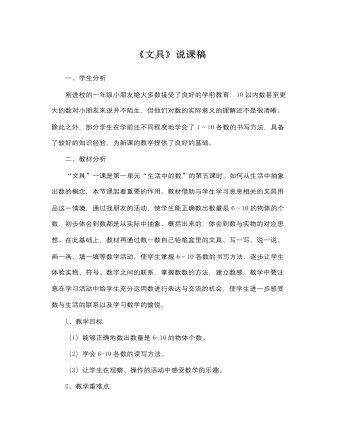
北师大版小学数学一年级上册《文具》说课稿
一、学生分析刚进校的一年级小朋友绝大多数接受了良好的学前教育,10以内数甚至更大的数对小朋友来说并不陌生,但他们对数的实际意义的理解还不是很清晰。除此之外,部分学生在学前还不同程度地学会了1~10各数的书写方法,具备了较好的知识经验,为新课的教学提供了良好的基础。二、教材分析“文具”一课是第一单元“生活中的数”的第五课时。如何从生活中抽象出数的概念,本节课起着重要的作用。教材借助与学生学习息息相关的文具用品这一情境,通过找朋友的活动,使学生能正确数出数量是6~10的物体的个数,初步体会到数都是从实际中抽象、概括出来的,体会到数与实物的对应思想。在此基础上,教材再通过数一数自己铅笔盒里的文具、写一写、说一说、画一画、填一填等数学活动,使学生掌握6~10各数的书写方法,逐步让学生体验实物、符号、数字之间的联系,掌握数数的方法,建立数感。

